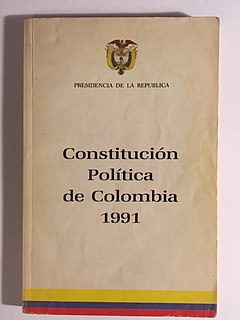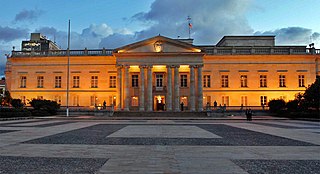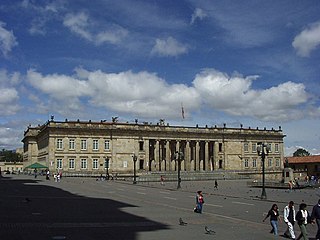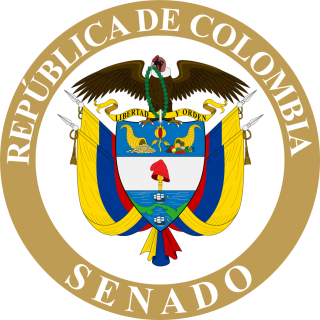 W
WThe Government of Colombia is a republic with separation of powers into executive, judicial and legislative branches. Its legislature has a congress, its judiciary has a supreme court, and its executive branch has a president.
 W
WThe Cámara de Comercio de Cúcuta or Chamber of Commerce of Cúcuta is a non-profit entity of the government of Colombia, attached to the Ministry of Industry, Commerce and Tourism. The jurisdiction is the city of Cúcuta and its Metropolitan Area.
 W
WThe House of Representatives is the lower house of the Congress of Colombia. It has 172 members elected to four-year terms.
 W
WThe Political Constitution of Colombia of 1991, is the Magna Carta of the Republic of Colombia. It was promulgated in Constitutional Gazette number 114 on Thursday, July 4, 1991, and is also known as the Constitution of Human Rights. It replaced the Political Constitution of 1886 and was issued during the presidency of the liberal César Gaviria, with ideas from the also liberal Luis Carlos Galán.
 W
WThe Congress of the Republic of Colombia is the name given to Colombia's bicameral national legislature.
 W
WThe constitutional history of Colombia is the process of formation and evolution of the different constitutions that Colombia has had since its formation.
 W
WThe Council of Ministers of the Republic of Colombia is composed of the most senior appointed politicians of the executive branch of the Government of Colombia. Members of the Cabinet are generally the heads of a Ministry Department. The existence of the Cabinet dates back to the first President Simon Bolivar. These members were appointed in order to advise the President and are therefore required to assist him in his duties as stated by the Colombian Constitution.
 W
WThe Diario Oficial is the official journal of the Government of Colombia that contains the laws, decrees, acts, and most pertinent documents and public notices of the President, Congress, and government agencies of Colombia. It is a daily publication, and was established on 28 April 1864 by means of an executive decree issued by President Manuel Murillo Toro; its first issue appeared on 30 April 1864, publishing the legal information of the day before.
 W
WThe Executive Branch of Government in Colombia is one of the three branches of the government of Colombia under the Constitutional provision of separation of powers. The executive branch is led by the President of Colombia and its collaborating institutions; mainly the Council of Ministers and administrative departments supporting the executive branch.
 W
WThe judiciary of Colombia is a branch of the State of Colombia that interprets and applies the laws of Colombia, to ensure equal justice under law, and to provide a mechanism for dispute resolution. The judiciary comprises a hierarchical system of courts presided over by judges, magistrates and other adjudicators.
 W
WThe Legislative Branch of Government in Colombia is one of the three branches of the government of Colombia under the Constitutional provision of separation of powers. The legislative branch of government is represented by the Congress of Colombia, which is formed by the Senate of Colombia and the Chamber of Representatives. Both houses of Congress are further subdivided into commissions (committees) and "sub commissions" to discuss determined subjects.
 W
WThe National Electoral Council is a Colombian institution under the Colombian Constitution of 1991 which based in Article 265 is in charge of the supreme inspection and vigilance of the electoral organization. The National Electoral Council is supposed to know and decide when and where an election is going to take place. The entity also watches over the Colombian political parties and political movements, their publicity and marketing, polls to guarantee the opposition or minorities also achieve a fair political aspiration.
 W
WThe President of Colombia, officially known as the President of the Republic of Colombia is the head of state and head of government of Colombia. The office of president was established upon the ratification of the Constitution of 1819, by the Congress of Angostura, convened in December 1819, when Colombia was the "Gran Colombia". The first president, General Simón Bolívar, took office in 1819. His position, initially self-proclaimed, was subsequently ratified by Congress.
 W
WThis article covers national and international security issues in Colombia.
 W
WThe Senate of the Republic of Colombia is the upper house of the Congress of Colombia, with the lower house being the House of Representatives. The Senate has 108 members elected for concurrent (non-rotating) four-year terms.
 W
WThe vice president of Colombia is the first in the presidential line of succession, becoming the new President of Colombia upon leave of absence or death, resignation, or removal of the president, as designated by the Colombian Constitution of 1991 which also reinstated the vice president figure after almost a century of being abolished during the presidency of Rafael Núñez. The vice president cannot assume presidential functions on temporary absences of the president such as official trips abroad or vacations. In these cases, the president delegates functions to a cabinet member, usually the Minister of the Interior. Marta Lucía Ramírez is the current vice president.